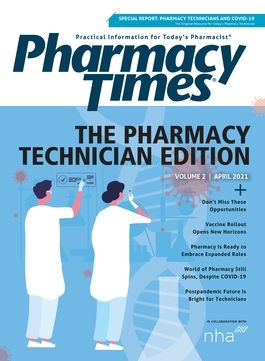Publication
Article
Supplements
World of Pharmacy Still Spins, Despite COVID-19
Technicians and other pharmacy professionals have been focused on the pandemic, but now can turn to what's next.
The world of pharmacy has remained steadfast, with escalating drug costs, the seemingly never-ending opioid crisis, and workforce issues.
Pharmacy professionals are continuously working to reduce medical expenses and increase provider access through health care reform. However, drug shortages continue to drive medication costs up, which results in reduced medication adherence. The end of 2019 brought the coronavirus disease 2019 (COVID-19) and forced the pharmaceutical industry to find common ground in 2020. A new normal is beginning to blossom from the struggles of 2020, and 2021 will be about figuring out how best to navigate this challenging new era of pharmacy.
Several new drugs were developed and existing drugs were reevaluated during the COVID-19 pandemic to try to halt the spread of disease. These developments have created ample opportunities for pharmacists and pharmacy technicians to take part in hundreds of clinical trials and participate in mass vaccination clinics. To date, there are more than 500 clinical trials of antivirals, convalescent plasma, stem cell therapy, and vaccines.1 Community and hospital pharmacy staff members have been called upon to step up and help vaccinate patients by developing protocols and new workflows that will maintain their operational needs while adjusting to the public health emergency. Many community pharmacists are required to maintain certification and training to administer immunizations. However, only a handful of states allow techs to do so. Idaho, Michigan, Nevada, Rhode Island, Utah, and Washington state are carving the way for techs to take on more hands-on clinical roles. The US Department of Health and Human Services has released guidance to allow qualified techs to administer COVID-19 vaccines during the public health emergency. The pandemic has created new advancement opportunities for techs to expand their knowledge and skills and help make a significant contribution to ending this worldwide threat. Techs are needed to travel to locations where the virus has spread and taken out the local workforce so patients can still receive the care they need from their local medical facilities. Techs can help set up and monitor vaccine clinics while becoming frontline immunizers.
Thus far, 2021 has brought on more cause for concern and vulnerability in the geriatric population regarding the adherence of medications as well as the ease of accessibility. Advanced age (≥ 60) in conjunction with diminishing physiological functions and underlying health conditions have been deemed major risk factors for the development of severe COVID-19 infection.2 To minimize potential exposure, many ambulatory pharmacies have begun to implement home delivery and curbside pickup of medications. This is especially helpful in the case of patients who are immunocompromised. Decreasing medication adherence, coupled with the rise of drug costs and limited access to pharmacies, continue to be an issue within the elderly population, which in turn leads to significant and unwanted consequences.3 To combat adherence issues, numerous hospitals use techs to perform full medication reconciliation rounds on high-risk admitted patients, such as the geriatric population, while pharmacists counsel on prescribed medications and then follow up. In addition, some pharmacists and techs can work remotely to continue to develop rapport with patients.
The pandemic has brought on several anxieties and obstacles. One is burnout. Health care workers across the country have had to continue with work duties despite the increased potential for disease exposure. In 2020, 61.2% of pharmacists reported experiencing burnout.4 Because of the pandemic, pharmacy personnel are experiencing declining performance metrics, an increased workload, and tighter time constraints, in conjunction with a lack of control. The simple act of having to don personal protective equipment to walk the hospital floors can wreak havoc on an individual’s psyche. That, in turn, leads to an abundance of personal stress that can trickle out and affect others in the workplace. It is in times like these that leadership should be encouraging employees to work on projects, rather than focus on clinical work, facilitating interdisciplinary collaboration, and having workplace resources to assist with work-life balance. Several health systems have implemented wellness teams from which employees can seek help when they are feeling overwhelmed; join a group that focuses on individual wellness, such as a walking group; or practice meditation and mindfulness.
This year will be one of change, growth, and perseverance. We are living through a worldwide health crisis we have not seen the likes of since the 1918 influenza pandemic. The year 2021 is about changing the ways we care for patients through innovative technology. It is a year of learning new skills that contribute to personal growth and make us more valuable to society. It is a year of tenacity and hope that this, too, shall pass, and that the world of pharmacy will demonstrate its contributions and show that it has only just begun to shine.
AUTHOR BIO
Yvonne Fairbanks, RPhT, CPhT, CSPT, is pharmacy technician supervisor of sterile compounding in the Department of Pharmacy Services at UC Davis Medical Center in Sacramento, California.
REFERENCES
- Thorlund K, Dron L, Park J, Hsu G, Forrest JI, Mills EJ. A real-time dashboard of clinical trials for COVID-19. Lancet Digit Health. 2020;2(6):e286-e287. doi:10.1016/S2589-7500(20)30086-8
- Dhama K, Patel SK, Kumar R, et al. Geriatric population during the COVID-19 pandemic: problems, considerations, exigencies, and beyond. Front Public Health. 2020;8:574198. 2020. doi:10.3389/fpubh.2020.574198
- MacLaughlin EJ, Raehl CL, Treadway AK, Sterling TL, Zoller DP, Bond
CA. Assessing medication adherence in the elderly: which tools to use in clinical practice?. Drugs Aging. 2005:22(3)231-255. doi:10.2165/00002512- 200522030-00005 - Padgett EH, Grantner GR. Pharmacist burnout and stress. US Pharmacist. May 15, 2020. Accessed March 16, 2021. https://www.uspharmacist.com/article/pharmacist-burnout-and-stress






